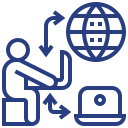
Identify and Assess Security Weaknesses with Application Vulnerability Scanning
Identify and mitigate security weaknesses in your software with Application Vulnerability Scanning, which ensures robust protection against cyber threats and compliance with industry standards.

What is Application Vulnerability and Scanning?
Application Vulnerability Scanning is like an automated security checkup for your software. It scans the code for weaknesses that attackers could exploit, such as injection flaws or broken authentication. Early detection helps you patch these vulnerabilities and prevent cyberattacks.

Why is Application Vulnerability and Scanning Important?
AVS is vital because vulnerable applications are prime targets for hackers. Regular scans identify weaknesses in your software's code, like security holes, before attackers find them. This allows you to fix these vulnerabilities quickly, preventing data breaches and protecting your applications.

Why Suraksha’s Application Vulnerability and Scanning (AVS)
Our service utilise automated tools to meticulously scan applications, identifying and addressing potential vulnerabilities. With a focus on proactive risk mitigation, we enhance the security posture of applications, safeguarding sensitive data and ensuring uninterrupted business operations.
Yotta's Application Vulnerability Scanning (AVS) excels with advanced automation, pinpointing and remedying potential vulnerabilities swiftly. Our USPs include comprehensive scanning precision, rapid threat mitigation, and seamless integration, providing end customers with unparalleled assurance in fortifying their applications against evolving cyber threats.
Features
Automated Scanning
Utilizes automated tools to conduct thorough scans of applications, ensuring comprehensive coverage and efficiency.
Precise Vulnerability Identification
Pinpoints vulnerabilities with precision, providing accurate insights into potential security weaknesses.
Rapid Remediation Recommendations
Offers swift and actionable recommendations for mitigating identified vulnerabilities, minimizing the window of exposure.
Continuous Monitoring
Enables ongoing monitoring to detect new vulnerabilities that may arise as applications evolve.
Customizable Scanning Policies
Tailors scanning policies to match specific application requirements and security needs.

Integration Capabilities
Seamlessly integrates with existing security infrastructure and workflows for cohesive vulnerability management.

Scalability
Scales to meet the growing demands of diverse application portfolios, ensuring flexibility and adaptability.

Comprehensive Reporting
Generates detailed reports outlining identified vulnerabilities, remediation actions, and overall security posture.

Prioritisation of Risks
Prioritises identified vulnerabilities based on severity, allowing organisations to address high-risk issues promptly.

User-Friendly Interface
Provides an intuitive interface for easy management, monitoring, and interpretation of scanning results.

Regulatory Compliance Support
Assists organisations in maintaining compliance with relevant industry regulations and data protection standards.

Threat Intelligence Integration
Incorporates threat intelligence feeds to enhance vulnerability scanning accuracy and relevance.

Asset Discovery and Classification
Discovers and classifies assets within the application environment for a holistic understanding of potential risks.

Cloud and On-Premises Support
Extends scanning capabilities to both cloud-based and on-premises applications, ensuring comprehensive coverage.

Continuous Updates
Regularly updates scanning tools and vulnerability databases to stay current with emerging threats and exploit techniques.
Use Cases






